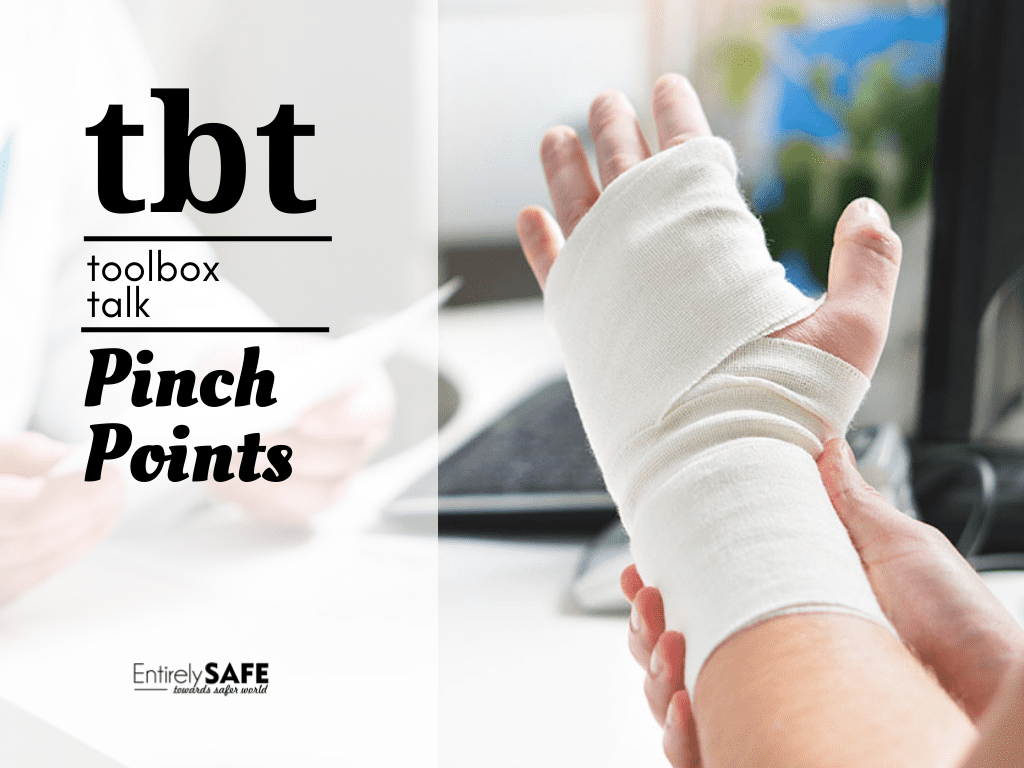Pinch Points Toolbox Talk

Before the Toolbox Talk
This safety talk is designed for discussion leaders to use in preparing safety meetings. Set a specific time and date for your safety meeting. Publicize your meeting so everyone involved will be sure to attend. Review this safety talk before the meeting and become familiar with its content.
Make notes about the points made in this talk that pertain to your workplace. You should be able to present the material in your own words and lead the discussion without reading it.
Seating space is not absolutely necessary, but arrangements should be made so that those attending can easily see and hear the presentation. Collect whatever materials and props you will need ahead of time. Try to use equipment in your workplace to demonstrate your points.
Give the safety talk in your own words. Use the printed talk merely as a guide. The purpose of a safety meeting is to initiate a discussion of safety problems and provide solutions to those problems. Encourage employees to discuss hazards or potential hazards they encounter on the job. Ask them to suggest ways to improve safety in their area. Don’t let the meeting turn into a gripe session about unrelated topics. As a discussion leader, it’s your job to make sure the topic is safe. Discussing other topics wastes time and can ruin the effectiveness of your safety meeting.

Toolbox Talk: Pinch Points
To most of us, a pinch doesn’t sound too serious. A pinch on the cheek or a friendly pinch for fun is one thing, but the pinches you get on the job are something else.
Recently, a worker was crushed to death against a wall by a huge truck that was backing up. That was a pinch point accident.
In another instance, a pair of pliers slipped and pinched a worker’s hand, which caused a blood blister.
Between these two extremes lie hundreds of pinch-point situations in the industry.
And there are just as many examples of injuries sustained because of these pinch points on the record.
Pinch point conditions are one of the most difficult hazards to guard. For example, let’s look at a set of two in-running calendar rolls used to finish cloth or manufacture paper or rubber. The material in the process must reach the in-running rolls to be carried through; no guard can be placed at the immediate point. There are some partial guards on such equipment, but operators must exercise extreme caution and alertness when these rolls are running, which is usually at a very high speed and under considerable pressure.
Closely stored 55-gallon steel drums, when moved or handled, create pinch points between each other or the dolly being used to move them. Because the drums are round, they are more difficult to handle and control in many cases.
Here the only protection is care and alertness.
The same thing applies to heavy crates, castings, and boxes that are stacked close to each other.
Improperly guarded punch presses can inflict more serious injuries. However, most punch presses are well guarded by two-hand trip and photoelectric beams.
These must be used with part-revolution presses; they cannot be used with full-revolution presses. Full revolution presses must have a guard–barrier, two-hand control, or similar positive device. Proper guarding prevents entry over, under, around, and through.
It is dangerous to work around machinery that has oscillating or reciprocating parts or elements. Of course, most of these areas are guarded, but in cases when guards are removed to do work or make adjustments, be sure the parts cannot move or be moved. Tag out or lockout the equipment and be sure the machinery cannot cycle if it is off balance or activated by accident.
There are many commonplace things that are potential pinch points, like heavy steel doors or heavy covers for bins and hoppers, and often there is no way to guard these hazards. Care is your only safeguard. Even extension ladders can create serious pinch points; the rungs sliding past each other can catch fingers, hands, and feet.
Roller, belt, or chain conveyors create many pinch points. On a roller-skate-wheel conveyor, heavy crate, castings, and other materials that are too close together can even cut off a finger. Powered conveyors are most dangerous at floor openings and at the beginnings and ends if they run inclined between different levels.
A little thought will bring to mind the many pinch points (sometimes called nip points) here in our own operation. Let’s discuss some of them now.
Interactive Discussion
- Have you or someone you know been injured or nearly injured while carrying out this activity? What happened?
- How can we stay safe today?
- What do we do at the worksite to prevent injuries related to this activity?
After the Toolbox Talk
At the end of the meeting, ask employees to sign a sheet on the back of this talk as a record that they attended the safety meeting. Keep this talk on file for your records.

